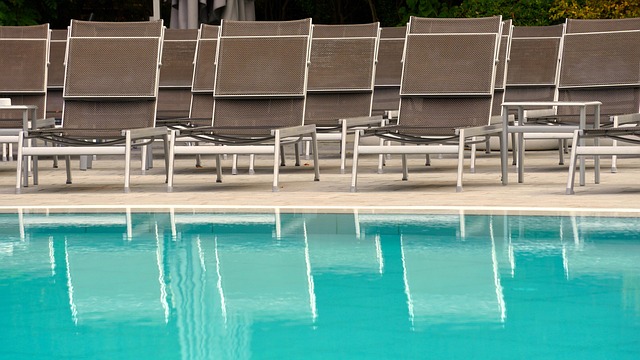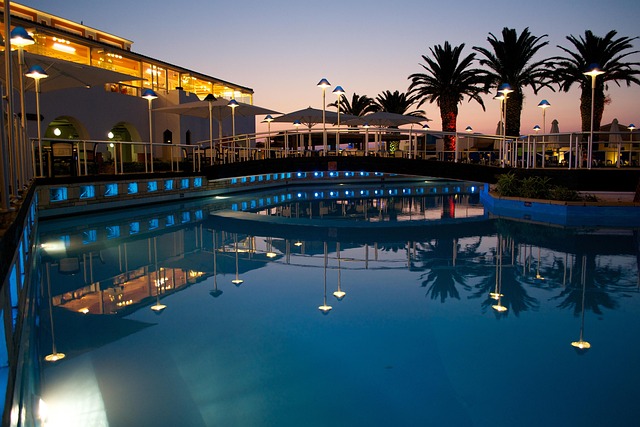Outdoor pool decking combines safety and aesthetics. Key considerations include slip-resistant surfaces, effective drainage, and handrails for safety. Choosing durable, non-slip materials ensures regulatory compliance and visual appeal. Incorporating natural elements or modern design trends enhances the space's functionality and beauty. Regular maintenance is crucial to preserve these features, providing a safe and aesthetically pleasing outdoor pool area for years to come. Prioritizing accessibility through slip-resistant surfaces and well-defined pathways further enhances safety and inclusivity.
“Elevate your outdoor space with expertly designed pool surrounds, where safety meets stunning aesthetics. This comprehensive guide explores the art of crafting durable and secure decks for your outdoor pool area. From understanding essential safety features like non-slip surfaces and guardrails to discovering design ideas that transform your poolside into a harmonious extension of your home’s style, we delve into every aspect. Learn how to choose safe, long-lasting materials and ensure accessibility while enhancing the overall beauty of your outdoor pool decking.”
- Understanding Outdoor Pool Decking: Essential Safety Features
- Incorporating Aesthetics: Design Ideas for Stunning Pool Surrounds
- Material Considerations: Choosing Safe and Durable Options
- Enhancing Safety and Accessibility: Important Design Aspects to Consider
Understanding Outdoor Pool Decking: Essential Safety Features

Outdoor pool decking is more than just a surface where swimmers take their laps; it’s a vital component that combines safety and aesthetics, enhancing the overall experience around an outdoor pool. When designing or choosing decking for your outdoor pool area, several key safety features must be considered to ensure a secure and enjoyable environment. These include slip-resistant surfaces, especially crucial in areas surrounding pools where water splashes and creates slippery conditions. Proper drainage systems are also essential to prevent pooling water on the deck, which could lead to slipping hazards.
Additionally, handrails and guardrails play a critical role in outdoor pool decking safety, offering support and preventing accidents, especially for older individuals or children. The choice of materials should be non-slip and durable enough to withstand varying weather conditions while maintaining its structural integrity. Incorporating these safety features seamlessly into the design not only meets regulatory standards but also contributes to the overall beauty and functionality of your outdoor pool decking.
Incorporating Aesthetics: Design Ideas for Stunning Pool Surrounds

When designing a pool surround, aesthetics play a crucial role in enhancing the overall look and feel of your outdoor space. The right design can transform a simple swimming area into a stunning centrepiece that captivates the senses. One popular approach is to incorporate natural elements, such as incorporating stones, pebbles, or small plants into the decking. These organic touches not only add visual appeal but also create a harmonious connection between the pool and its surroundings.
Additionally, modern design trends offer a wealth of creative ideas. For instance, using contrasting materials like wood and concrete can produce dramatic effects. Incorporating curved lines and organic shapes further emphasizes the fluidity of nature, while strategically placed lighting can add depth and mystery to the pool area after dark. Remember, an aesthetically pleasing pool surround should seamlessly blend form and function, ensuring both safety and visual delight for years to come.
Material Considerations: Choosing Safe and Durable Options

When designing a pool surround, selecting the right materials is paramount for both safety and aesthetics. Outdoor pool decking should ideally be slip-resistant to prevent accidents, especially when wet. Durable materials like non-slip tiles, natural stone, or high-performance composite decking not only enhance safety but also offer a long-lasting solution that can withstand varying weather conditions.
Additionally, considering the material’s maintenance requirements is essential. Some options may require regular cleaning and sealing to maintain their integrity and visual appeal. Others, like concrete or brick, while durable, might necessitate occasional repairs and resealing. Choosing materials that align with your lifestyle and desired upkeep level ensures a safe and visually appealing outdoor space for years to come.
Enhancing Safety and Accessibility: Important Design Aspects to Consider

When designing a pool surround, safety and accessibility should be at the forefront of every decision. One of the key considerations is creating slip-resistant surfaces for outdoor pool decking. This is crucial to prevent accidents, especially in areas with high moisture content or frequent water splashing. Non-slip textures or specialized coatings can enhance traction, ensuring users feel secure while navigating around the pool.
Additionally, designing clear pathways and ramps leading to the pool area improves accessibility for people of all abilities. Wide, smooth paths free from obstructions facilitate easy movement, including for individuals using wheelchairs or mobility aids. Well-planned outdoor pool decking design not only enhances safety but also creates a welcoming and inclusive environment for everyone who enjoys the poolside experience.
Designing an outdoor pool area is not just about aesthetics; it’s a balance between safety, functionality, and visual appeal. By incorporating the right features from understanding essential safety aspects to choosing suitable materials, you can create a stunning and secure pool surround. Remember, safe and well-designed outdoor pool decking enhances the overall experience, ensuring your space becomes a beautiful and accessible sanctuary for all.
